Animal coloration is such a significant thing done by nature. Animals possess different types of coloration, which helps to camouflage, warn predators, and avoid predators. Have you ever seen blue and red beetles? They are so beautiful and loved by insect lovers.
14 Blue & Red Beetles
1. Red and Blue beetle
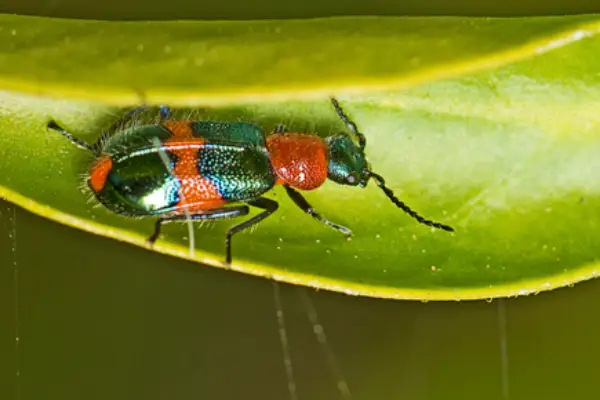
| Scientific name | Dicranolaius bellulus |
| Size | 0.8-1.5 cm |
| Diet | Phytophagous |
| Geographical location | Australia |
This Australian endemic species is also known as the “red and blue beetle” because of its striking blue and red appearance.
It is a small beetle with an average size of 0.8–1.5 cm and has a shiny red body with blue and red metallic elytra.
They show dramatic sexual dimorphism. Males have enlarged antennae, which they use during mating.
They are phytophagous and usually feed on the nectar and pollen of flowers. It is a beneficial insect for farmers, as they use it as a biocontrol agent.
2. Hibiscus harlequin beetle
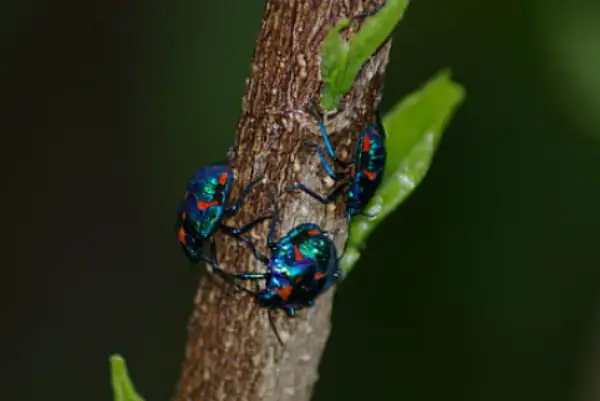
| Scientific name | Tectocoris diophthalmus |
| Size | 2 cm |
| Diet | sap feeder |
| Geographical location | Australia, Indonesia |
The hibiscus harlequin bug or The cotton harlequin bug are common names for Tectocoris diophthalmus.
Their striking blue and red appearance is an incredible sight for insect enthusiasts.
One can easily distinguish between females and males. Males are blue with some red or orange spots, whereas females are orange with blue.
They commonly feed on hibiscus, cotton crops, etc., and are found in Australia and Indonesia.
3. Florida predatory stink beetle

| Scientific name | Euthyrhynchus floridanus |
| Size | 12-17 mm |
| Diet | Carnivorous |
| Geographical location | Southeastern United States |
It is known as the “Florida predatory stink bug” because it is native to Florida and feeds on many pest insect species.
It has a bluish-black or purplish-black body with red spots at the corner of the scutellum. They are very beneficial to agriculturists for natural pest control.
4. Platycorynus undatus
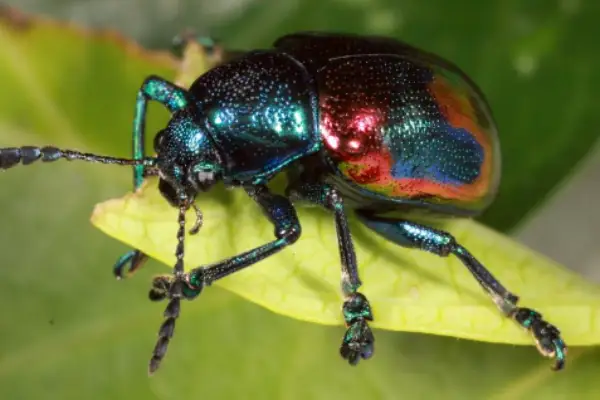
| Scientific name | Platycorynus undatus |
| Size | No information |
| Diet | Phytophagous |
| Geographical location | Asia |
This fascinating beetle, Platycorynus undatus, belongs to the Chrysomelidae family and is commonly found in Asia. They have striking metallic blue coloration with red bands on their elytra.
According to recent research, they use their antennas to sense predators, which helps them avoid them. It feeds on the leaves of various plants, such as Acacia, Cassia, and Mimosa.
5. Kuschelina gibbitarsa
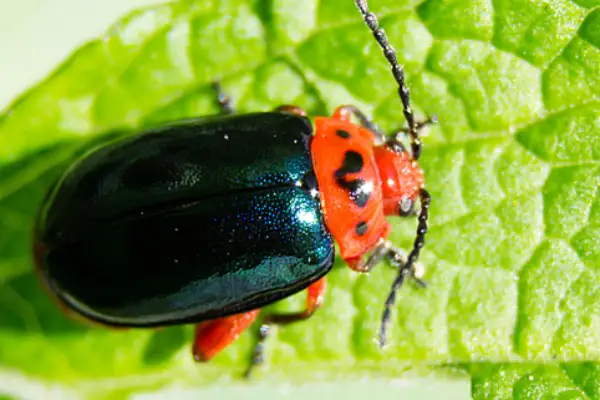
| Scientific name | Kuschelina gibbitarsa |
| Size | 5.4-6.3 mm |
| Diet | Herbivore |
| Geographical location | North America |
Kuschelina gibbitarsa is a flea beetle commonly found in North America. Like other flea beetles, they are small and can attain a length of up to 5.4–6.3 mm.
They have characteristic metallic blue elytra with a red head and thorax.
They are pests on several plant species, including mint, yarrow, etc. To protect the crop, farmers use several biological controls, predators feed on the larvae of these species.
6. The Shiny Flea Beetle

| Scientific name | Asphaera lustrans |
| Size | 7 mm |
| Diet | Herbivore |
| Geographical location | Central and North America and Mexico |
This small beetle of length 7 mm is commonly found in Central North America and Mexico. As the name indicates, they have a shiny metallic bluish-green body with a red head and thorax.
Like other flea beetles, they can also jump long distances. These nocturnal beetles get attracted to the light. They are the major problem for mint fields, and farmers often use raw covers to protect them from shiny flea beetles.
7. Red blue checkered beetle

| Scientific name | Trichodes nuttalli |
| Size | 8-10 mm |
| Diet | omnivore |
| Geographical location | Eastern North America |
The “red-blue checkered beetle” is the common name of Trichodes nuttalli. These elongated beetles are 8 to 10 mm in size and have characteristic blue and red coloration.
They have bluish elytra with red bands over them. They use their cryptic coloration to warn predators that they are poisonous and not worth eating. It is harmless to humans and not considered a pest.
They are very similar to blister beetles found in Asia in appearance, and people often get confused with them.
8. Cereal leaf beetle
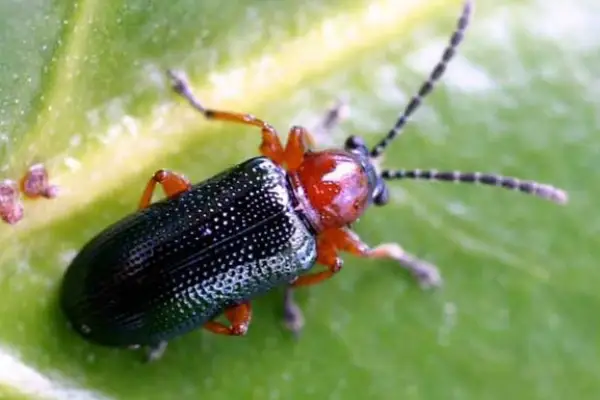
| Scientific name | Oulema melanopus |
| Size | 5 mm |
| Diet | Herbivore |
| Geographical location | Europe and Asia |
As the name indicates, they are a significant threat to cereals. The adults of this beetle are bluish in color with a red thorax and can reach a size of 5 mm.
They are commonly found in Europe and Asia and feed on the superficial layer of leaves, disturbing photosynthesis.
They are univoltine, which means they produce one generation during one breeding season. Researchers have come up with a lot of suggestions to control them.
9. Disonycha politula
| Scientific name | Disonycha politula |
| Size | 5-6 mm |
| Diet | Herbivore |
| Geographical location | Central and North America |
Another species of flea beetle, Disonycha politula, is known for its distinctive characteristics. Adults of this species are small, with an average body size of 5 to 6 mm.
They have greenish-blue elytra with a red thorax and antennae. There is not much information available about these beetles, but they are thought to take one year to complete their life cycle.
They act as pests on various plants, including amaranth plants, some weed plants, etc. Under this ability, agriculturists may often use them as biocontrol agents.
10. Mealybug Ladybird
| Scientific name | Cryptolaemus montrouzieri |
| Size | 6 mm |
| Diet | Carnivore |
| Geographical location | Eastern Australia |
You must have seen a black and red ladybird in your garden. But have you ever seen a blue ladybird? This Eastern Australian native beetle species is known for its incredible blue color and red thorax.
Their shape and size are very similar to those of the common ladybird. They are small and can attain a body size of up to 6 mm.
They are known as “mealybug ladybirds” because they possess a waxy covering on their wings, which makes them resemble mealy bugs and allows them to attack them better.
11. Steel blue Ladybird
| Scientific name | Halmus chalybeus |
| Size | 3-4 mm |
| Diet | Carnivore |
| Geographical location | Australia and New Zealand |
Halmus chalybeus exhibits a remarkable deep blue color and has a metallic body with black undertones and two red spots.
People can find these round beetles all across Australia and New Zealand.
It is a beneficial insect as it acts on other insect pests. They usually feed scale insects and protect other plants. They are small, with an average size of 4 mm.
12. Red-legged ham beetle
| Scientific name | Necrobia rufipes |
| Size | 3-7 mm |
| Diet | Omnivore |
| Geographical location | Cosmopolitan distribution |
The red-legged ham beetle has distinctive red legs. It is small, with an average size of 3.5 to 7 mm, and has metallic blue elytra and red legs and antennae.
It feeds on copra, bones, dried fish meat, etc., and is known to be a surface feeder.
13. Knotweed leaf beetle
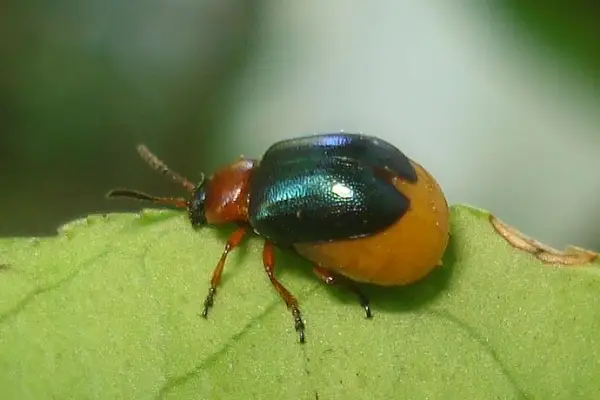
| Scientific name | Gastrophysa polygoni |
| Size | 3.9-5.0 mm |
| Diet | phytophagous |
| Geographical location | Europe and Asia |
It is known as a knotweed leaf beetle because it acts as a pest on knotweed plants. These beetles are small, with an average size of 3.9 to 5.0 mm. They are bluish-green with a red thorax and appendages.
Parasitoid wasps are considered one of their predators. It finds in various habitats, including meadows, fields, gardens, and wood edges.
They usually produce eggs in large numbers, like 200 at a time, and their whole life cycle gets completed in 4-6 weeks.
Their life cycles change according to their surrounding environment. This ability of this beetle makes it unique.
14. Dogbane beetle
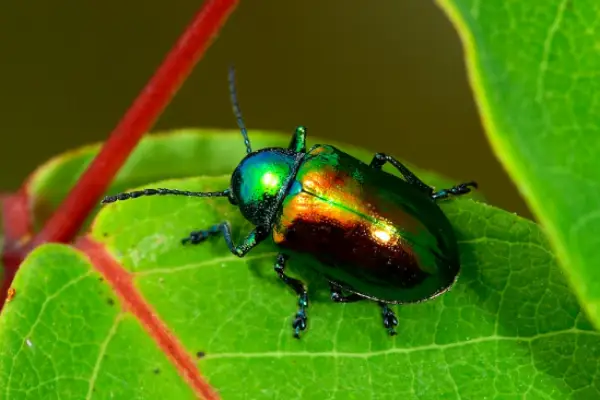
| Scientific name | Chrysochus auratus |
| Size | 8-11 mm |
| Diet | Herbivores mainly dogbane leaves |
| Geographical location | Eastern North America |
The dogbane beetle is the common name of Chrysochus auratus, found in eastern North America. These medium-sized beetles can grow up to 8 to 11 mm in size.
They have a dazzling metallic blue-green and reddish appearance with blue appendages. They usually feed on dogbane plant leaves, which contain toxins that can even cause cardiac arrest.
These beetles got this toxin and used it as a defense mechanism. Their mating rituals are also fascinating. Males use sex pheromones to find the fittest females for mating.
Conclusion
In conclusion, blue and red beetles may look like small and insignificant parts of nature, but they play a crucial role in balancing ecosystems.
By observing, appreciating, and reading about these beetles, we can increase our knowledge and understand the deeper secrets of nature. We will come up with another article on such creatures soon; until then, go through this.
Also Read:

Being a zoology student I’m always been fascinated toward animals especially insects. I love to do research and learn about different animals. As a writer I want to share my thoughts about nature through my articles. Apart from this you can find me exploring the new places and voice notes.

